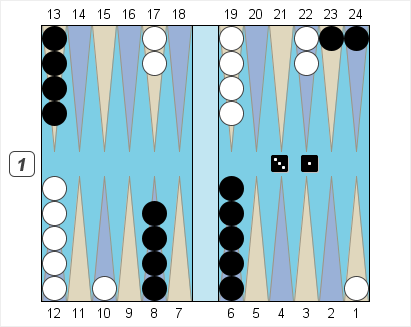
Black – Pips 161
Black to Play 3-1
(b) Black to play 3-2.
Here’s a typical early game position where neither side has made much progress yet. White has played a 5-3 and a 6-3, making his 3-point and running a checker into the outfield. Black has rolled a 5-1, balancing his builders and splitting his back men.
The 3-1 and 3-2 rolls give Black a choice between hitting and making a good point. Lots of players hit automatically in these positions, not really believing that any non-hitting play can be good. But that’s not right. Constructive positional plays are often better than hitting, especially in the early game when boards are weak. Not always, however; sometimes hitting is, in fact, correct. Before we address the particulars of the position, let’s take a general look at the rules that guide this sort of choice. I’ll list a bunch of features of the position, and which choice each favors:
> A strong home board favors hitting; a weak home board favors building a point.
> A big disadvantage in the race favors hitting; a close race is neutral.
> The more ground you can gain in the race by hitting, the more correct it’s likely to be. Hitting a blot in your opponent’s inner or outer boards is usually correct; hitting a blot in your own outer board is sometimes a mistake.
> Strong threats for your opponent favor hitting as a tempo play or making a defensive anchor; few threats favor making an offensive point.
> Stacks of checkers favor making a point; no stacks imply plenty of points already, which favors hitting.
With those principles in mind, let’s start with the first roll, 3-1. Here everything points to making the 5-point as the best play. Black has no home board and big stacks, and making the 5-point fixes both problems. The race is close, hence relatively neutral. The blot to be hit is in Black’s outer board, only a modest argument for hitting. The stacks strongly favor unstacking and make the 5-point. White has only weak threats, which is an argument for structure.
The weight is strongly in favor of 8/5 6/5, which is in fact the best play with a 3-1.
Playing a 3-2 is a different sort of problem. Now the choice is between hitting or making a good anchor, so a lot of those arguments disappear, since Black can’t do anything about his stacks. Here the real question is: how badly does Black need an anchor? And the answer is: not much. White doesn’t have a strong attacking formation, and Black’s rear checkers are already well-placed. Hitting also works now as a tempo play, taking away half of White’s roll and reducing his offensive chances still further. The best hitting play is just 13/10* 23/21, keeping a spare on the midpoint and preparing to make a good anchor later.
One more point before we leave this position. Players who go on long losing streaks often feel they are rolling incredibly badly for long periods of time. In fact, what’s often happening is that they are steaming and making mistakes in just these sorts of positions, taking the first play they see instead of thinking the position through. Thus they tend to drift into bad positions more often than they should.





